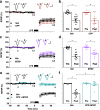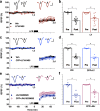Physiological activation of mGlu5 receptors supports the ion channel function of NMDA receptors in hippocampal LTD induction in vivo
- PMID: 29535352
- PMCID: PMC5849730
- DOI: 10.1038/s41598-018-22768-x
Physiological activation of mGlu5 receptors supports the ion channel function of NMDA receptors in hippocampal LTD induction in vivo
Abstract
Synaptic long-term depression (LTD) is believed to underlie critical mnemonic processes in the adult hippocampus. The roles of the metabotropic and ionotropic actions of glutamate in the induction of synaptic LTD by electrical low-frequency stimulation (LFS) in the living adult animal is poorly understood. Here we examined the requirement for metabotropic glutamate (mGlu) and NMDA receptors in LTD induction in anaesthetized adult rats. LTD induction was primarily dependent on NMDA receptors and required the involvement of both the ion channel function and GluN2B subunit of the receptor. Endogenous mGlu5 receptor activation necessitated the local application of relatively high doses of either competitive or non-competitive NMDA receptor antagonists to block LTD induction. Moreover, boosting endogenous glutamate activation of mGlu5 receptors with a positive allosteric modulator lowered the threshold for NMDA receptor-dependent LTD induction by weak LFS. The present data provide support in the living animal that NMDA receptor-dependent LTD is boosted by endogenously released glutamate activation of mGlu5 receptors. Given the predominant perisynaptic location of mGlu5 receptors, the present findings emphasize the need to further evaluate the contribution and mechanisms of these receptors in NMDA receptor-dependent synaptic plasticity in the adult hippocampus in vivo.
Conflict of interest statement
The authors declare no competing interests.
Figures






Similar articles
-
Developmental switch from LTD to LTP in low frequency-induced plasticity.Hippocampus. 2006;16(11):981-9. doi: 10.1002/hipo.20228. Hippocampus. 2006. PMID: 17016817
-
Critical differences in magnitude and duration of N-methyl D-aspartate(NMDA) receptor activation between long-term potentiation (LTP) and long-term depression (LTD) induction.Acta Med Okayama. 2008 Feb;62(1):21-8. doi: 10.18926/AMO/30989. Acta Med Okayama. 2008. PMID: 18323868
-
Adenosine A2A receptors are required for glutamate mGluR5- and dopamine D1 receptor-evoked ERK1/2 phosphorylation in rat hippocampus: involvement of NMDA receptor.J Neurochem. 2018 May;145(3):217-231. doi: 10.1111/jnc.14268. Epub 2018 Jan 23. J Neurochem. 2018. PMID: 29205377
-
Hippocampal long-term synaptic plasticity and signal amplification of NMDA receptors.Crit Rev Neurobiol. 2006;18(1-2):71-84. doi: 10.1615/critrevneurobiol.v18.i1-2.80. Crit Rev Neurobiol. 2006. PMID: 17725510 Review.
-
The new compound GET73, N-[(4-trifluoromethyl)benzyl]4-methoxybutyramide, Regulates hippocampal Aminoacidergic transmission possibly via an allosteric modulation of mGlu5 receptor. Behavioural evidence of its "anti-alcohol" and anxiolytic properties.Curr Med Chem. 2013;20(27):3339-57. doi: 10.2174/09298673113209990167. Curr Med Chem. 2013. PMID: 23862615 Review.
Cited by
-
Dendritic autophagy degrades postsynaptic proteins and is required for long-term synaptic depression in mice.Nat Commun. 2022 Feb 3;13(1):680. doi: 10.1038/s41467-022-28301-z. Nat Commun. 2022. PMID: 35115539 Free PMC article.
-
Neuromodulators and Long-Term Synaptic Plasticity in Learning and Memory: A Steered-Glutamatergic Perspective.Brain Sci. 2019 Oct 31;9(11):300. doi: 10.3390/brainsci9110300. Brain Sci. 2019. PMID: 31683595 Free PMC article. Review.
-
Long-Term Depression-Inducing Low Frequency Stimulation Enhances p-Tau181 and p-Tau217 in an Age-Dependent Manner in Live Rats.J Alzheimers Dis. 2022;89(1):335-350. doi: 10.3233/JAD-220351. J Alzheimers Dis. 2022. PMID: 35871344 Free PMC article.
-
Effects of blocking mGluR5 on primate dorsolateral prefrontal cortical neuronal firing and working memory performance.Psychopharmacology (Berl). 2021 Jan;238(1):97-106. doi: 10.1007/s00213-020-05661-2. Epub 2020 Sep 16. Psychopharmacology (Berl). 2021. PMID: 32939596 Free PMC article.
-
Bioactive human Alzheimer brain soluble Aβ: pathophysiology and therapeutic opportunities.Mol Psychiatry. 2022 Aug;27(8):3182-3191. doi: 10.1038/s41380-022-01589-5. Epub 2022 Apr 28. Mol Psychiatry. 2022. PMID: 35484241 Review.
References
Publication types
MeSH terms
Substances
LinkOut - more resources
Full Text Sources
Other Literature Sources

